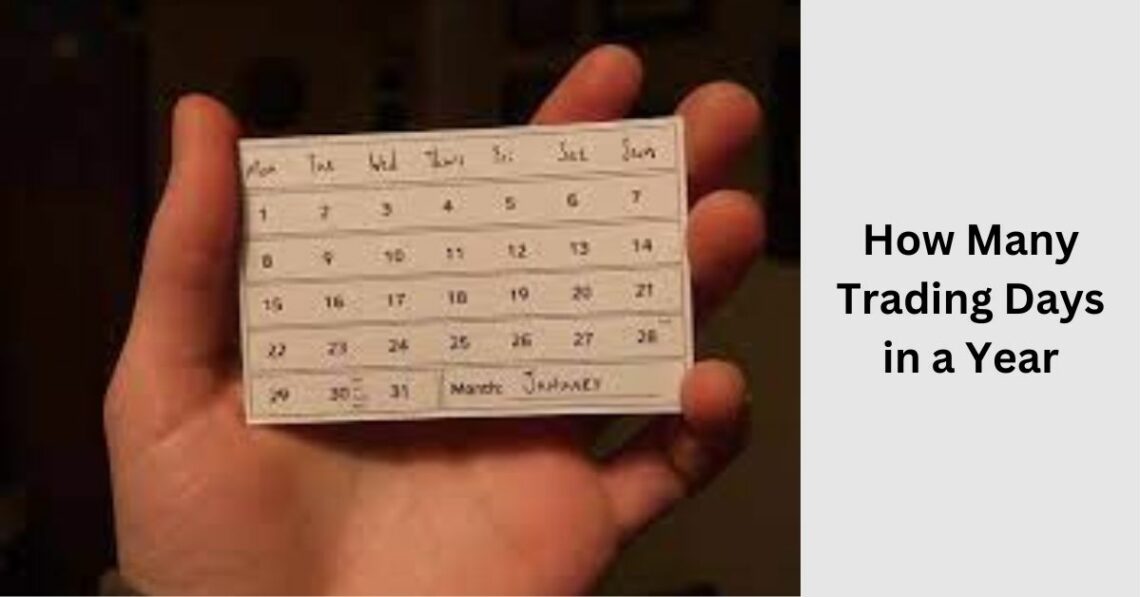
Navigating the Markets: How Many Trading Days in a Year?
Trading in financial markets is a dynamic and fast-paced endeavor, with investors and traders constantly analyzing trends, making decisions, and executing trades. One fundamental aspect that plays a crucial role in this process is the number of trading days in a year.
Understanding this key metric is essential for anyone involved in the world of finance. In this article, we’ll delve into the intricacies of trading days, exploring why they matter and how they impact market participants.
The Basics:
In a standard calendar year, there are typically 252 trading days. These are the days when financial markets are open for business, allowing participants to buy and sell various assets such as stocks, bonds, commodities, and currencies. The number 252 is derived from the fact that there are 365 days in a year, excluding weekends and public holidays. Weekends alone account for 104 days (52 weeks multiplied by 2 days), and there are around 9 public holidays in the United States, where major financial markets are located.
Why It Matters:
The limited number of trading days in a year has significant implications for investors and traders. It means that every trading day is valuable, and market participants need to make the most of their opportunities within this finite timeframe. Additionally, the compressed nature of the trading year can lead to heightened volatility, as market reactions to news and events are concentrated within a relatively short period.

Moreover, the concept of trading days is crucial for calculating returns and measuring performance. Annualizing returns involves taking the daily returns and adjusting them to a yearly scale, which is only accurate when the exact number of trading days is considered.
Seasonal Patterns:
Understanding the number of trading days in a year also allows market participants to observe and analyze seasonal patterns. Certain months or periods may exhibit consistent trends or tendencies due to various factors, such as corporate earnings reports, economic data releases, or geopolitical events. Traders often use historical data and the knowledge of trading days to anticipate and capitalize on these patterns.
Global Variations:
While 252 trading days is the standard for major financial markets like the New York Stock Exchange, it’s important to note that different countries may have different trading calendars. Some markets may have more or fewer trading days depending on local holidays and customs. Investors with a global perspective need to be aware of these variations to effectively navigate and trade in international markets.
Market Opening Hours:
Trading days are not only defined by the number of days in a year but also by the specific hours during which markets are open. Most major financial exchanges have designated opening and closing hours, creating distinct trading sessions.
For example, the New York Stock Exchange typically opens at 9:30 AM and closes at 4:00 PM (Eastern Time). These time constraints add another layer of complexity for traders, as they must strategize and execute their trades within this limited daily window. Understanding these market hours is essential for investors to plan their activities and respond to market movements effectively.
Impact on Investment Strategies:
The finite number of trading days in a year also influences investment strategies. Long-term investors, such as those focused on retirement savings or mutual funds, may not be as affected by the daily fluctuations.
However, for day traders or those employing short-term trading strategies, the limited number of trading days heightens the importance of timing and precision. These traders often thrive on short-term market movements, making each trading day a crucial opportunity to capitalize on price fluctuations.

Market Events and Volatility:
The compressed nature of trading days can contribute to increased market volatility. When significant events, such as earnings reports, economic data releases, or geopolitical developments, occur, their impact is concentrated within the available trading days.
This can lead to rapid and substantial price movements, creating both opportunities and risks for market participants. Traders need to stay vigilant and be prepared for sudden shifts in market sentiment that can occur within the confines of the trading calendar.
Technology and 24/7 Trading:
While traditional exchanges have fixed trading hours, advancements in technology have given rise to electronic trading platforms that operate 24 hours a day. Cryptocurrency markets, for instance, are known for their continuous trading. This development has expanded opportunities for traders to access markets outside of standard trading hours.
However, it also poses challenges, as investors must navigate the potential for increased volatility during non-standard hours. The integration of technology into financial markets continues to reshape the landscape, blurring the lines between traditional trading days and continuous, global access to financial instruments.
Holiday Effects and Market Closures:
Beyond weekends, public holidays can significantly affect the number of trading days in a year. Market closures on holidays disrupt the regular flow of trading and impact liquidity. Additionally, holidays often coincide with extended weekends, creating extended periods of market inactivity.
Traders and investors need to be aware of these breaks in the trading calendar and adjust their strategies accordingly. The absence of market participants during these closures can sometimes lead to gaps in price movements, emphasizing the importance of planning for potential market shifts when trading resumes.
Strategic Planning and Risk Management:
Understanding the finite number of trading days in a year is a cornerstone of strategic planning and risk management. Traders need to set realistic goals, considering the constraints imposed by the trading calendar.
Having a well-defined strategy, risk tolerance, and exit plans becomes crucial when each trading day holds a premium value. Additionally, the limited trading days underscore the importance of diversification and risk mitigation strategies.
By spreading investments across different assets and markets, investors can reduce their exposure to the potential risks associated with the condensed trading schedule, fostering a more resilient and adaptable investment approach.
Conclusion:
In the fast-paced world of financial markets, the number of trading days in a year is a fundamental factor that influences investment decisions, market dynamics, and performance measurement.
Traders and investors should embrace the finite nature of these days, recognizing the opportunities and challenges they present. By understanding the nuances of trading days, market participants can navigate the ever-changing landscape with greater insight and confidence.
You May Also Like

The Ultimate Guide to Buying Synthetic Ice Panels: What You Need to Know
August 1, 2023
Tips for Improving Gut Health
February 6, 2024

